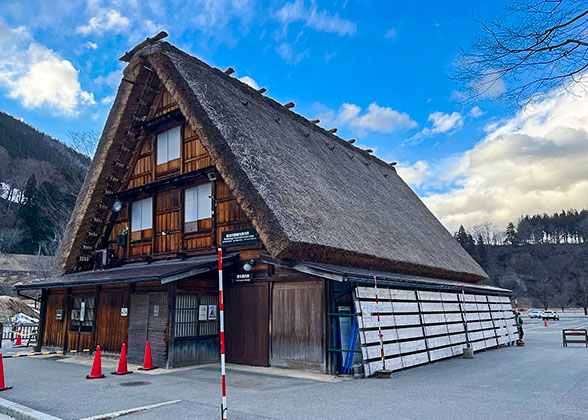Shirakawa-go

Shirakawa-go Photos ( 18
|
The village is tranquil most of the time, but the Winter Light-Up Festival would see it overcrowded with tourists. Many houses in the village are still inhabited, among souvenir stores, eateries, inns, and guesthouses where travelers can take an onsen or hot spring bath. There is also a museum to learn about Shirakawa-go’s history. Fans of the Japanese anime Higurashi: When They Cry will be excited to find a familiar landscape, which its Hinamizawa Village is modelled after.
Quick Takeaways
![]() The Winter Light-Up Festival in 2024 would be the 38th to be held.
The Winter Light-Up Festival in 2024 would be the 38th to be held.

A panorama of Shirakawa-go in winter
|
The Iconic Gassho-style Houses
As Shirakawa-go is situated in a region where to encounter the heaviest snowfall in Japan, local farmers have invented a unique architecture, called “Gassho”, for their houses that helps them survive winter. Viewed from sides, the roof design resembles two hands with fingertips joining together, which reminds people of the Buddhist gesture for prayer. The angle between the two “hands” are steep enough to let piled snow slide off and thus prevent themselves from collapse. The wisdom of ancestors is also revealed in the south or north direction most of the houses faces, which reduces the impact of wind and lets more sunlight in during winter. More surprisingly, such houses were built without a single nail.What makes these Gassho-style houses so special also include the top floors serving as the place to raise silkworms, which greatly contributed to the local economy during the Edo (1603 - 1868) and early Showa (1926 - 1989) periods. Making use of the risen hot air from the ground floor in winter, they provided a warmer space for those silk producers to grow.
|
|
|
Opening hours of the museums: 9:00 am – 5:00 pm
Admission fee of the museums: 300 – 400 yen.
Observatories for a Bird-Eye View
There are two observatories for tourists to have a panoramic view of Shirakawa: Ogimachi Castle Ruins Observation Deck and Tenshukaku Observatory. The former offers a closer view of the village, while the latter is where to find a more sweeping view of the landscape around.
|
|
|
A Lit Wonderland for Winter Light-Up Festival
Because of the special regional climate, the snow that falls from December to March in Shirakawa-go can sometimes pile up to 4.5 meters (14.8 feet) deep, carpeting the roofs and roadsides and giving a surreal feel to the entire village. It enjoys an even more otherworldly vibe when houses are illuminated during Winter Light Up Festival. The warm light, filtering through windows and reflected by the white snow, would make everyone’s imagination run wild.2024 will mark the 38th year to hold the Light Up Festival. The village is scheduled to be lit six times next year from 17:30 to 19:30 on January 14th, 21th, and 28th, as well as on February 4th, 12th, and 18th.
Note:
![]() To prevent overcrowding during the festival, travelers are not allowed to use camera tripods on the Observation Deck.
To prevent overcrowding during the festival, travelers are not allowed to use camera tripods on the Observation Deck.
|
|
|
Know Before Going
Admission: Shirakawa-go can be visited all year round for free, except occasions for visiting houses and joining Light-Up Festival, which have been mentioned.Time needed: 2 – 3 hours.
Tips:
How to Get There?
However remote Shirakawa-go is, it can be easily approached from Nagoya, Takayama, and Kanazawa, the latter two being the nearest popular city portals.

A map to locate Shirakawa-go
|
From Nagoya:
Nagoya’s Meitetsu Bus Center is directly connected with Shirakawa-go by Gifu Bus (about 3 hours, 3,400 – 4,200 yen). This would be the most convenient way if you’ve included Nagoya in your travel itinerary.
Or, you can transfer to Takayama from Nagoya and then take Nohi Bus to Shirakawa-go, but it’d be unnecessary unless you want to explore Takayama.
|
|
|
From Kanazawa:
Kanazawa is directly linked with Tokyo by JR Hokuriku Shinkansen bullet train (about 2.5 hours, 14,000 yen). While in Kanazawa, take Nohi Bus from Kanazawa Station to Shirakawa-go (85 minutes, 2,600 yen).
Generally travelers would go there by bus, but renting a car from nearby cities for a self-driving tour is also a nice alternative.
Shirakawa-go Photos & Shirakawa-go Video